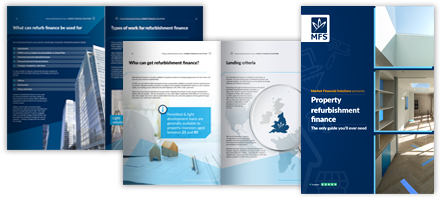
With recent bouts of high inflation, rising interest rates, and plateauing house prices, many will be considering ways to increase the value of their homes. Extending a property is one way of doing this.
We are frequently asked how to fund an extension. Some borrowers remain in the dark about the amount they can borrow, let alone the factors that can influence these amounts. For borrowers considering an extension who may have similar questions, this blog should provide some clarity.
What is an extension?
First, let us define what an extension is. In short, the term ‘extension’ means to extend a property that already exists to increase its overall floor size. Many extensions may focus solely on the ground floor, but that isn’t to say that extensions cannot cover more than one storey.
Usually, extensions are done by adding another room, or making an existing room larger. Often, extensions require borrowers to sacrifice a part of their garden or driveway.
Types of extensions
Before even thinking about how to fund an extension, homeowners must consider the type of extension they want to invest in. So, what different types of extension are there?
1. Front and rear extensions
These types of extension are implemented at the front or back of a building. They usually occur on a garden or patio area. Typically, one would opt for these extensions if they want to create a larger open plan living space, or blend their indoor space with their outdoor space.
For small extensions, planning permission may not be required, potentially saving hassle and time costs. Indeed, these extensions usually require between three to six months of building time. However, it would be wise to always check planning regulations regardless of size.
Front extensions specifically often require planning permission, which may be rarely granted. On average, rear extensions cost around £40,000[1], and front extensions may prove even more costly.
2. Single-storey extensions
This type is one of the most common extensions that homeowners take on. Typically, they are used to increase the size of an older property’s kitchen.
Single-storey extensions can be built at the side or the rear of a property. They use of any surrounding garden or driveway space that is used infrequently which makes them highly flexible. These extensions often use French or bi-fold doors to help blend the outdoor space with a home.
Generally, single-storey extensions cost between £1,800 and £3,000 per square metre, according to Checkatrade[2].
3. Two-storey extensions
Two-storey extensions create extra floor space on two different levels of a home. Again, they are commonly used on period properties.
These extensions allow owners to extend their kitchen or living area, while also adding an extra bedroom or bathroom, in one project. Generally, the extra cost of a two-storey extension scales well.
As such, one can expect to pay a similar amount per square metre as they would with a single-storey extension. However, in London, the average cost could be substantially higher, at between £3,000 and £3,500 per square metre[3].
4. Side extensions
For homeowners with a small path or alleyway that runs along the side of their property, a side return extension could be a good option.
As these tend to be smaller projects, they do not require planning permission. (Although again, we would recommend checking planning regulations.) They can still transform the living area of a home.
Depending on the size of the path or alleyway, a homeowner can expect to pay around £30,000 for a side extension, with a 12-week completion timeframe[4].
5. Wrap-around extensions
Sometimes referred to as ‘L-Shape extensions’, this type of extension is a combination of side and rear extensions. As such, they make use of side paths and garden space to add floor space along the width and length of a property. A wrap-around extension can cost anywhere between £50,000 and £100,000[5].
6. Conservatory house extension
A conservatory would represent a slightly different style of extension. One that can give a property additional living space, and a bright separate area that can be used as sun-filled lounges, playrooms and dining rooms.
Unlike other extensions, of course, conservatories are typically made with glass walls and roofs. Also, these often come with some unique building regulations homeowners must adhere to and can slow down the process.
Conservatory costs can vary widely across the UK, and by project scope. Generally, they may cost between £9,000 and £25,000 for a fully fitted conservatory[6].
Costs of an extension
While we have provided some rough estimates of the costs that the different types of extension entail, property investors should be aware of what factors may contribute to the final budget of an extension project.
Indeed, when considering how to fund an extension, such due diligence could prevent bills from spiralling.
For the most part, the cost of an extension can vary based on the following factors:
- Type of extension
- Size of extension
- Complexity of the extension’s design
- Location of the property
- Quality of materials and tradesmen
- Condition of the property’s site
- Supply and demand in the market
On top of this, you will need to factor in the cost of fit-out items. Additional costs like planning permissions and fit-out items can add about 5% to a total bill[7].
Moreover, there could be extra costs from surveyors, architects, and structural engineers. Not to mention any regulations, or neighbour agreements that an extension might need to adhere to:
- Architects – typically account for around 10% of the construction cost
- Engineers – between £1,500 and £2,500 on average
- Surveyors – usually 1-3% of a total project value[8]
- Planning permission – from £258 in England[9]
- Party Wall Agreements – if needed, costs can rise to between £1,000 and £3,000 per neighbour

Value added to a house through funding an extension
As to be expected, this depends on the type and quality of the extension involved. A typical 15 square meter side extension, for example, could add 5-10% to a property’s value, or £15,000-£30,000 for the average UK home[10].
Single storey extensions can add between 10% and 20% in value[11], whereas a full-width rear extension creating open-plan living spaces often deliver 10–18% value increases, particularly when they enhance connection to the outdoors[12].
What’s important to remember is that results will vary across the UK, and by individual circumstances.
How to fund an extension?
Once a plan is settled on, homeowners must then think about how to fund an extension. Fortunately, there are plenty of options out there for them.
1. Home improvement loan
A home improvement loan is a type of personal loan that can be used to pay for improvements to a property, such as an extension.
At Market Financial Solutions, our refurbishment bridging loans can be used to carry out permitted and light development work where needed, regardless of whether the work is being done to increase house value or for restoration purposes.
An advantage of these loans is that they can provide funding quickly, while borrowers could also benefit from our flexibility where unexpected issues emerge.
Perhaps they started an extension project, only to discover major plumbing problems that need sorting first. Or maybe the materials they planned to use are more expensive than expected, creating a worryingly larger bill.
2. Remortgage
Homeowners might also consider remortgaging their properties. Indeed, moving to a new lender or deal is another way of freeing up the capital needed to fund an extension.
That said, there is a higher level of risk they’ll will need to borrow the money against the property itself. As such, if the default on payments, they could lose your home. There are also early repayment fees if they plan to remortgage during an agreed term.
3. Refinance loan
To give some breathing space when remortgaging, one could consider using a refinance loan. A refinance bridging loan allows borrowers to replace existing finance secured against a property. This may be needed if they run out of capital before completing an extension project, or if they need more time to formulate a new plan.
4. Pay by credit card or savings
Another finance option is to pay for any extension with a credit card, or even dip into savings. One benefit of paying by credit is that borrowers will get some protection due to Section 75 of the Consumer Credit Act. Therefore, if any problems arise, they may not lose out completely.
An advantage of using savings, is that there is no need to borrow any extra money. But the question is whether a person would want to use their own money – perhaps an emergency fund for property repairs – to finance extension works.
How much can you borrow for an extension?
At Market Financial Solutions, how much one can borrow will depend on the work they are carrying out. If they are planning to carry out a large extension/conversion project, they will need permitted development finance. This funding can stretch to £20,000,000.
Light development loans are typically used for smaller refurbishments that do not require planning permission. Our refurbishment loans start from £100,000.
What can influence how much you can borrow?
As mentioned above, the work being carried out will impact how much can be borrowed. But there are other influences as well.
For one, one’s income and pre-existing financial commitments will affect the amount that they can borrow. As such, any loans already taken out will be examined, as well as how much they can afford to pay in repayments.
Elsewhere, most lenders will look at a borrower’s credit history to find out how reliable they are as a customer. At Market Financial Solutions, however, we take on deals that may not fit in with a mainstream lender’s tick-box criteria, enabling us to assist borrowers with potential issues in their financial histories.
For homeowners who choose to remortgage their properties, the value of the property will also influence the amount they can borrow. Lenders will find out how much a property is worth by conducting a valuation of the property. That valuation will then determine exactly how much they can lend out.
With Market Financial Solutions, it is easy to find out how much can be borrowed, as we have a bridging loan calculator that does the initial work for our clients.
With this tool on hand, they can rest assured that we will deliver the best financial option for their needs. To find out more about our products, check out our website.
The Complete Guide to
Refurbishment Finance
Everything you need to know
- Basics of refurbishment
- Different finance types
- Lending criteria & calculator
- Real life case studies
[1] https://www.myjobquote.co.uk/costs/rear-extension
[2] https://www.checkatrade.com/blog/cost-guides/house-extension-cost/
[3] https://www.houseup.co.uk/news/double-storey-extension-guide
[4] https://www.myjobquote.co.uk/costs/side-extension
[5] https://www.myjobquote.co.uk/costs/rear-extension
[6] https://www.conservatoryland.com/frequently-asked-questions/conservatory-prices/#:~:text=On%20average%2C%20prices%20range%20between,P%2Dshape%2C%20for%20example.
[7] https://resi.co.uk/advice/house-extensions/house-extension-cost
[8] https://www.homebuilding.co.uk/advice/how-much-does-an-extension-cost
[9] https://hoa.org.uk/advice/guides-for-homeowners/i-am-improving/cost-of-planning-permission/
[10] https://www.philliparnoldauctions.co.uk/article/the-true-value-of-an-extension
[11] https://www.uswitch.com/loans/guides/home-improvements-that-can-add-value-to-your-home/#:~:text=Single%20Storey%20Extension&text=According%20to%20Checkatrade.com%2C%20the,home%20when%20it%20is%20finished.
[12] https://sellhousefast.uk/blog/how-much-value-does-an-extension-add/






